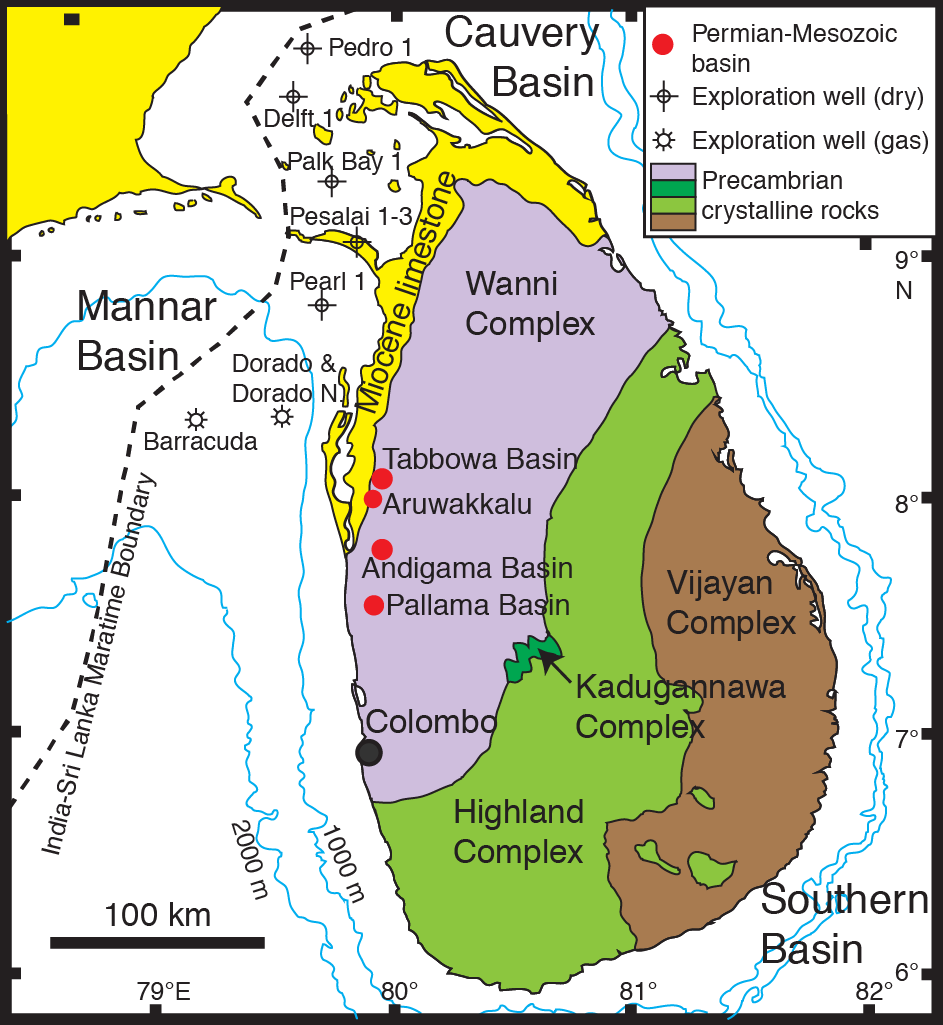Tabbowa-Andigama Gr
Type Locality and Naming
Named after towns of Tabbowa and Andigama. "The Tabbowa Basin is a small graben previously considered to host only Jurassic strata. The basin extends over an area of only a few square kilometers in the Northwestern Province of Sri Lanka. … A similar succession is developed 30 km to the south of Tabbowa in the Andigama–Pallama Basin, which hosts at least 350 m of strata. The surrounding Precambrian basement rocks comprise mainly granitic gneisses with extensive jointing and faulting." (Edirisooriya et al., 2016, Geol. Mag. 155:907-920).
Synonym: Tabbowa Series and Andigama Series. Equivalent to Kota Stage (Sahni, 1956)
[Figure: Generalized geologic map of Sri Lanka (from Edirisooriya et al., 2016, Geol. Mag. 155:907-920)]
Lithology and Thickness
Clayey sandstone. The upper Gondwana strata called the Tabbowa series consists of conglomerates, sandstones, shales and nodular limestones. The sandstone and shales contain plant impressions and thin coal seams near Andigama. "The Tabbowa graben developed in a crystalline basement terrane and hosts nearly 1000 m of strata consisting mostly of grey to reddish shales, mudstones, siltstones and arkosic sandstones.
Relationships and Distribution
Lower contact
Major unconformity: Around 90% of the bedrock in Sri Lanka consists of Precambrian crystalline rocks. Jurassic, Miocene and Quaternary strata are largely confined to a thin belt of exposures in the north and northwest of the island
Upper contact
Major unconformity: The next younger exposed unit is Minihagal Kanda Beds Fm (Miocene); but it is on the north coast, but not these basins.
Regional extent
The upper Gondwana rocks usually were deposited in the faulted grabens. These rocks have been encountered near the Andigama around 25 km south of Tabbowa and are expected to continue further south. "There are 2 small areas of Jurassic deposits in Tabbowa and Andigama (around Puttalm) and in the South East."
GeoJSON
Fossils
"The palynological study of the Tabbowa sediments from Sri Lanka reveals predominant Jurassic gymnospermous pollen assemblage (Araucariacites australis, A. cooksonii, A. fissus and Callialasporites dampieri with spore Murospora florida) belongs to the Callovian-Kimmeridgian age. The collective palynoflora can be correlated to the Classopollis–Araucariacites–Shanbeipollenites assemblage zone of Africa and the Murospora florida zone of the Indian subcontinent and Australia, showing close phytogeographic relationships from the middle to late Jurassic periods." (Weerakoon et al., 2011, jour. Asian Earth Sci. 172: 264-278)
HOWEVER, based on one small exposure in Tabbowa Basin (without stratigraphic context) there is evidence of PERMIAN: "Most of the plant genera recorded in the new fossil assemblage (i.e. Paracalamites, Sphenophyllum, Glossopteris, Vertebraria and Samaropsis) have long ranges in the Permian strata of Gondwana. However, Dichotomopteris lindleyi, and indeed other members of this genus, are most common in Lopingian strata (Raniganj Fm and equivalents) in the rift basins of Peninsula India." (Edirisooriya et al., 2016, The first record of the Permian Glossopteris flora from Sri Lanka: Implications for hydrocarbon source rocks in the Mannar Basin Geol. Mag. 155:907-920)
Age
Depositional setting
Additional Information
